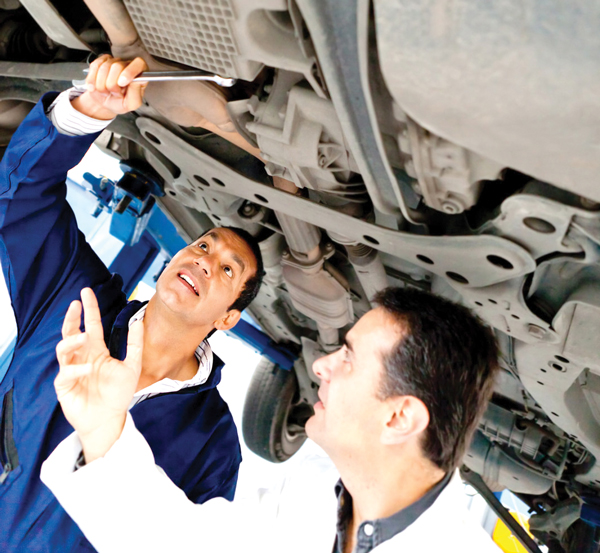BY JOE GUINN
 In an industry where we all struggle to put out proverbial fires, you shouldn’t have to worry about your buses bursting into literal flames. Fortunately, despite all the media attention surrounding bus fires lately, well-maintained vehicles are not in the habit of spontaneously combusting.
In an industry where we all struggle to put out proverbial fires, you shouldn’t have to worry about your buses bursting into literal flames. Fortunately, despite all the media attention surrounding bus fires lately, well-maintained vehicles are not in the habit of spontaneously combusting.
The alarming number of vehicle fires that have been making headlines recently does mean that your insurance companies and your customers are noticing, and you should be aware that high-occupancy buses and motorcoaches do contain large amounts of all the elements that can lead to a fire: fuel, heat, and air. Understanding the most common sources for these fires can help you be more alert and more aware of where to focus your prevention efforts—starting with the most common problem areas.
The three most frequent causes of bus fires are electrical issues, engine failure, and friction at the wheel. Performing thorough pre-trip and post-trip inspections, combined with regular maintenance and in-depth inspections, can eliminate most of these incidents.
Electrical failure fires usually start in one of three areas: the battery compartment, the engine compartment, or along the path of the electrical wires. As buses are often used for days at a time with heavy electrical loads driving many of the amenities that the modern traveler demands, it’s important to be aware of how these specific areas can affect your vehicle. Convenience items such as outlets, USB ports and chargers, WiFi devices, televisions, and custom lighting all put an increasingly large demand on your buses’ electrical systems.
Inside the engine compartment, the driver should always check for any loose or hanging wires in their pre- and post-trip inspections. Loose wires can vibrate against engine parts, destroying the protective sheath and causing a short, which may ultimately lead to a fire. Drivers should make sure that all wiring harnesses are neat and tucked away, clear from all other objects. If there is a wire loom or protective sheath over the wires, ensure that it is in good condition with no rips or tears. Train your drivers to inspect the whole length of the bus—inside, outside, and underneath—for any wires that are exposed or hanging. Cover or secure any loose wires found, prior to the start of the trip.
The battery compartments should be regularly maintained by your mechanics. Include inspection and maintenance of the compartment as part of every scheduled service interval. Posts and cables need to be free from excessive corrosion build-up, and the cables should be inspected for cuts or abrasions. Drivers should also check both daily: If a problem arises, it should be reported and corrected immediately.
 Electrical fires are additionally caused by improper or poor connections. It is important that your mechanic regularly inspects the electrical control panels that power your vehicle’s accessories. These panels usually have some type of access point that can easily be opened for inspection and maintenance. Chauffeurs should also be encouraged to report when electrical items are not functioning correctly, or sporadically, as this can be a sign of a poor connection. Buying a quality bus from a manufacturer that uses only premium parts can also reduce this risk. Lastly, never try to replace a blown fuse with a paper clip or other metallic object—doing so is a great way to burn your bus to the ground.
Electrical fires are additionally caused by improper or poor connections. It is important that your mechanic regularly inspects the electrical control panels that power your vehicle’s accessories. These panels usually have some type of access point that can easily be opened for inspection and maintenance. Chauffeurs should also be encouraged to report when electrical items are not functioning correctly, or sporadically, as this can be a sign of a poor connection. Buying a quality bus from a manufacturer that uses only premium parts can also reduce this risk. Lastly, never try to replace a blown fuse with a paper clip or other metallic object—doing so is a great way to burn your bus to the ground.
Engine failure is another frequent cause of fires, as well as a major expense even if a fire doesn’t occur. The engine is the single most expensive item in your bus and as such, a regular and thorough maintenance schedule should be followed religiously. Items like fluids and filter replacement should not be something that you allow to exceed your set parameters. This not only helps prevent premature engine failure, but also is a federal requirement affecting your DOT rating. The Federal Motor Carrier Safety Administration (FMCSA) requires that you have a written maintenance plan in place, that you follow it, and that you have complete and thorough files. Having a good maintenance tracking procedure in place is critical. If you need help or a recommendation for one, let’s talk at the Chauffeur Driver Show in D.C.
Chauffeurs are an integral component in preventing engine failure. A comprehensive pre-trip or post-trip inspection includes checking that all engine fluids are at their proper levels, making sure that belts are tight with no excessive wear or fraying, checking that the hoses are secure and firm fitting, as well as performing exhaustive visual inspections. The combustion engine is a closed system, meaning that the fluid inside an engine should remain in the engine under normal operating conditions: A close visual inspection will alert you to any moisture on the engine, chassis, or on the ground below the bus. This should be an immediate cause for alarm, and if a DOT inspector finds a fluid leak, your bus may be immediately taken out of rotation.
The most common source of fires is friction at the wheel. This can normally be narrowed down to one of three areas: Wheel bearings, brakes, or the tires, which are usually responsible for the majority of wheel-level friction fires.
Bearings are incorporated into the wheel system and ride in a bed of grease and heavy oil. This allows them to operate under a great amount of friction and torque without overheating and catching fire. The bearing system should be inspected by a trained mechanic at regular service intervals to ensure that they are operating within their very specific tolerances to prevent excessive heat and failure. Drivers should be trained to identify bearing leaks during their pre- and post-trip inspections. If they notice any oil dripping onto the wheel, it should be immediately reported, and the vehicle should not be operated again until the problem is identified and corrected. Even the slightest leak can lead to total failure in this system, which can result in fire or an expensive catastrophic parts failure.
The single greatest prevention of bus fires is the driver, so make sure that their concerns are listened to and that all of your staff understand the importance of proper maintenance and inspections."
Brakes must also be inspected daily. Bus brakes are typically driven by a slack adjuster that adjusts the brake pads as they wear thinner and thinner, allowing constant pressure to be applied to the wheel assembly and ultimately stopping the bus. In the event of a slack adjuster failure, the brake pads can make constant contact, which is essentially driving with the brakes on. This causes the brakes to continuously wear, and heat from that friction can easily escalate into a fire. Checking brake slack adjusters is a required part of a daily inspection, but one that many drivers admit to knowing the least about. Training should be regularly held with your drivers and mechanics so they can understand what it is they should be looking for when performing their inspections.
Tires should be a no-brainer but, unfortunately, many blowouts could have been easily preventable. Tire pressure is the number-one cause of premature tire wear and failure. Tires are designed to operate within a certain range as dictated by the tire manufacturer and used in conjunction with a specific vehicle. Improper tire pressure can result in dual tires rubbing together, and can cause excessive friction on the road. This causes heat to build, which can ignite grease or oil in the wheel and lead to a fire while driving down the road.
Ensuring that the tires are properly inflated should be a part of the daily inspection. Bus tires have very thick sidewalls, and a kick or a thump is not an adequate method to identify any issues. Companies should ensure that drivers have access to functioning tire gauges and an air compressor at all times. I personally have seen completely flat tires that appeared to be full when aligned in dual configuration.
The most important step in preventing bus fires is making sure that every driver conducts a thorough inspection before every trip without exception. Have someone observe your chauffeurs regularly. If they are only walking around the bus looking at lights or it takes them less than 15 minutes to do an inspection, they are costing you money—and ultimately putting your company’s reputation and future on the line, not to mention passenger safety. The single greatest prevention of bus fires is the driver, so make sure that their concerns are listened to and that all of your staff understand the importance of proper maintenance and inspections. Listen to them: Otherwise, you could see your buses—and your operation—go up in smoke. [CD1016]
Joe Guinn is the Owner of Atlimo & Bus Compliance. He can be reached at joe@dotbuscompliance.com.

